The diet for gout is based on minimizing the amount of purines in the diet, which helps to reduce the level of uric acid in the body and normalize metabolism. The basis of the diet is vegetables, fruits, berries, cereals, dairy products. The amount of meat and other protein foods should be limited. Diet is considered a mandatory part of treatment, because without it, drugs are ineffective.
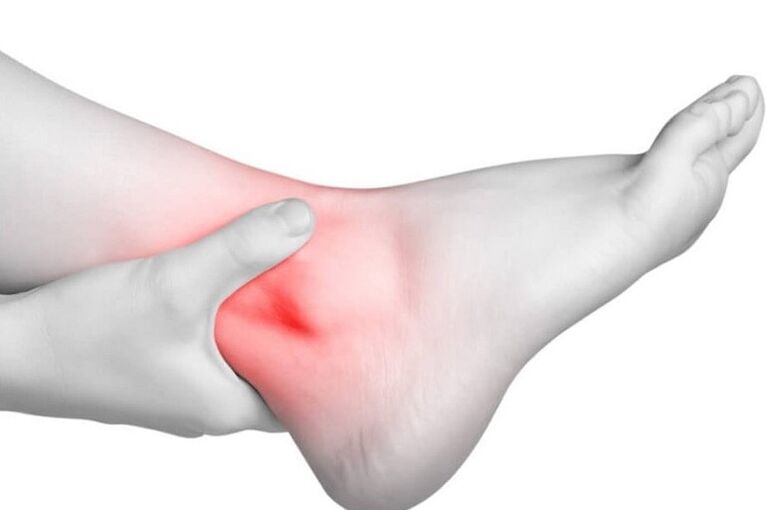
Advantages of gout diet
Benefits of nutrition therapy:
- a full-fledged diet with a fairly high calorie content allows you not to feel hungry;
- getting rid of harmful foods containing oxalic acid and purines, reduces the severity of gout symptoms, relieves pain, swelling;
- adherence to a diet reduces the risk of relapses and exacerbations;
- A healthy diet by limiting spicy, fatty, fried foods improves overall well-being and body condition;
- Proper nutrition reduces the risk of complications, including kidney failure, atherosclerosis, the formation of gout in the internal organs;
- Diet dishes are easy to prepare and do not require expensive ingredients.
Eating a diet can help lower uric acid levels and slow or stop the onset of gout.
Without concomitant therapy, proper nutrition can not completely cure a person, but it serves as a necessary aid in the fight against pathology and relieves the patient of painful symptoms.
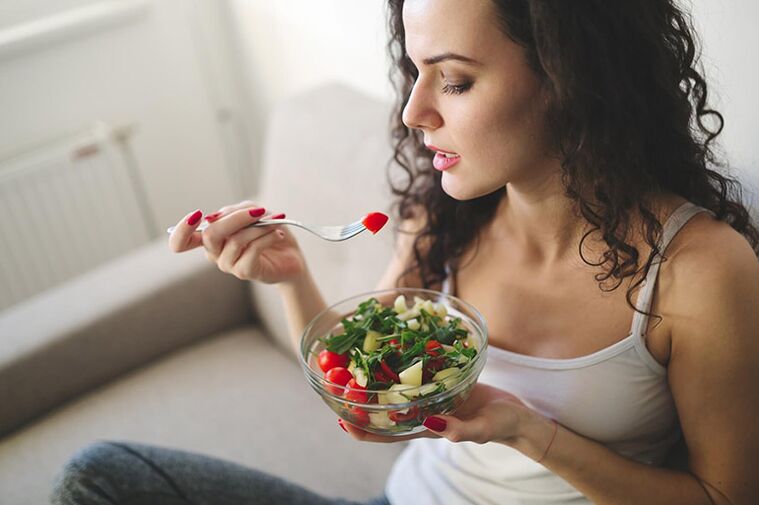
Basic principles of nutrition for gout and high uric acid
The purpose of the diet is to limit the intake of purines and intermediates that increase their concentration. Follow these rules when designing a diet:
- Meals per day are divided into 5 meals at regular intervals. Thus, they keep the metabolism in good condition and reduce the load on the digestive system and kidneys.
- The chemical composition of the food is carefully controlled. This helps to stop the deposition of salts in the tissues, helps to get rid of stones and gout tofu.
- The total caloric content of the diet is reduced to 2700 kcal per day, and the total weight of the meal should not exceed 3 kg. This allows you to maintain a normal body weight, as obesity contributes to the exacerbation of gout.
- The amount of protein is limited to 80 g per day. They try to replace animal proteins with plant proteins, but they cannot be completely ruled out.
- The daily fat norm is 80-90 g. About 25% enters the body with vegetable oils, the rest - in containers.
- The patient consumes a standard amount of carbohydrates - 400-450 g per day. They enter the body with grains, dried fruits and nuts.
- To neutralize excess acid, the menu includes many alkaline products: vegetables, milk and fermented dairy products, fresh fruits and berries. They will help the body maintain a balance of substances.
- All meats in the diet are pre-boiled for 15 minutes, after which the first broth is drained. Helps get rid of excess purines in muscle tissue
- Fluid intake increases to 2-2, 5 liters per day. The diet includes healthy drinks that have a diuretic effect, as well as alkaline drinks: fruit and berry juices, herbal teas and decoctions, milk, mineral water.
- The amount of salt is limited to 8-10 g per day. Its excess promotes the formation of sediments and reduces the rate of urination, which aggravates the symptoms of gout.
- Alcoholic beverages are excluded from the diet. Even their infrequent use impairs kidney function, which increases the risk of inflammation.
- If necessary, the diet is supplemented with vitamin and mineral complexes. It is important to maintain a proper level of vitamins B2, C, PP and potassium, which has a diuretic effect.
- Fasting days are held once a week, during which the patient eats only fruits, vegetables and grains that are weak in purines.
The diet should be combined with a dose of supportive medication, if prescribed by a doctor. Since gout is incurable, a person must follow a diet throughout his life.
What can you eat?
The following foods are allowed in the diet:
- Concerned bakery products, including black and white bread.
- Vegetables: dill, corn, beets, onions, garlic, potatoes, carrots, cabbage, broccoli, cucumbers, pumpkin, eggplant, squash. In limited quantities: tomatoes, turnips, cauliflower, radishes, asparagus, rhubarb, celery, peppers, onion feathers, parsley.
- All fruits and berries except grapes, cornel, figs and raspberries. Plums are consumed in limited quantities.
- Lean meat: rabbit, chicken, turkey. Consume no more than 3-5 times a week, serve up to 170 g.
- Low-fat fish (salmon, salmon, trout), seafood: mussels, shrimp, crab and crayfish, squid, octopus.
- Eggs - no more than 1. per day.
- Dairy products: kefir, cottage cheese, sour cream, yogurt, cream, unsalted cheese, low-fat milk (best diluted). Butter can be added to cereals, stews, but is not used for frying and is not consumed in its pure form.
- All grains and cereals, except legumes: rice, buckwheat, millet, oatmeal, etc. It is better to cook them in water or diluted milk.
- Weak vegetable broth, potato-based soups.
- Pumpkin, sunflower, flax, sesame seeds.
- Walnuts, pine nuts and hazelnuts, almonds, cashews, hazelnuts, pistachios.
- Dried fruits, except raisins.
- Vegetable oils: sunflower, olive, corn, flaxseed. They are used not only for frying, but also for preparing salads, stews and other things.
- Desserts: marshmallows, marmalade, jam, marshmallows, ice cream. Chocolate-free sweets are allowed.
- Drinks: fruit and vegetable juices (tomatoes are used with caution), herbal teas with lemon and honey, decoctions, fruit drinks, compotes, chicory, kvass. Alkaline mineral water is useful.
- Light spices and herbs: cinnamon, vanilla, bay leaf, citric acid. Light sauces based on sour cream, vegetable broth, vegetable oils.
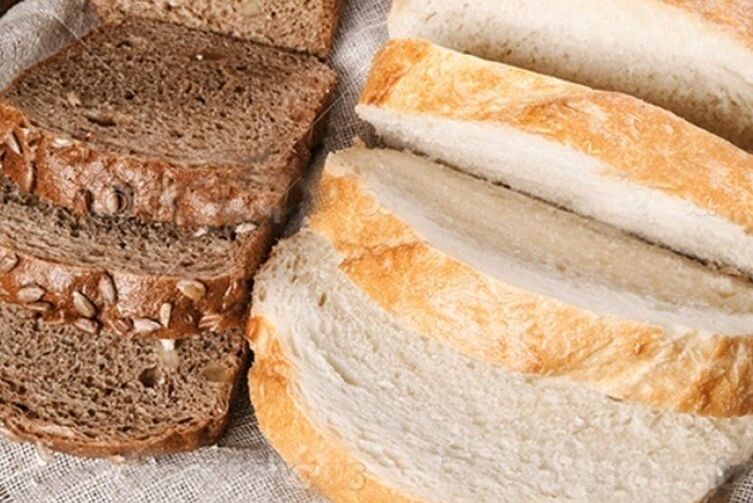
The diet includes large amounts of liquid and semi-liquid foods, light salads, vegetarian products. They not only help to reduce the concentration of purines, but also reduce the load on the gastrointestinal tract and kidneys.
What can you not eat
The following foods are unacceptable in the diet:
- Sweet dough.
- Fatty meats, dishes from young animals (beef, chicken), canned meat and smoked meats, sausages, sausages, small sausages and other semi-finished products.
- By-products.
- Salted, canned, smoked or fried oily fish, caviar.
- Peas, beans, lentils, soybeans and other legumes.
- Mushrooms.
- Sorrel, spinach, olives.
- Spicy and salty cheeses.
- Decoctions and broths based on meat and offal, fish, mushrooms.
- Cakes, sweets, cream buns.
- peanuts.
- Animal fats: lard, lard. margarine.
- Alcohol, strong tea, coffee, cocoa.
- Hot spices and sauces, including mustard, horseradish, mayonnaise, ketchup.
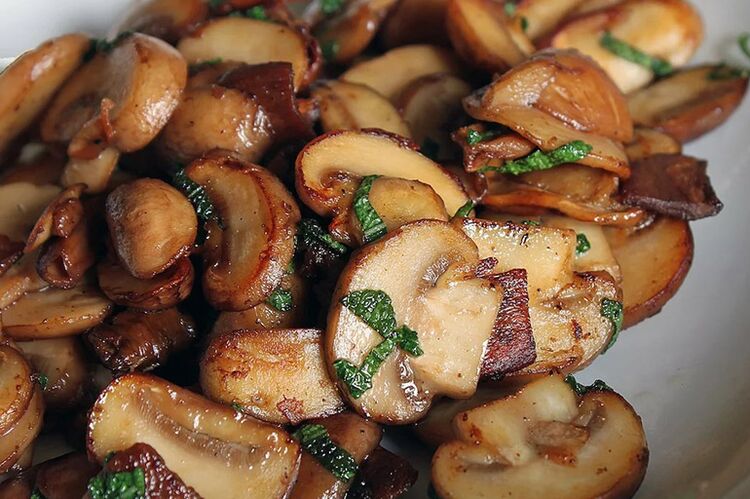
Eating spicy, fatty and fried foods can make your gout symptoms worse.
Table 6 for gout
Diet No. 6 is used in medical institutions to treat the disease. The medical menu takes into account factors such as the chemical composition of foods, their caloric content, the ratio of proteins, fats and carbohydrates. This allows you to choose the optimal diet for the patient, without having to make unnecessary calculations every time. Therefore, Table 6 is often used for the treatment of gout at home: it is universal and has no contraindications.
Diet during exacerbation
If gout symptoms worsen, it is recommended to change the menu. Rules of dieting in case of exacerbation:
- complete elimination of meat and fish from the diet;
- frequent fasting days - up to 4 per week;
- the basis of the diet is fresh fruits and vegetables;
- make sure you drink plenty of alkaline mineral water and other alkaline drinks;
- all dishes are served in liquid or semi-liquid form;
- eat often (7-8 times a day), with equal intervals between meals.
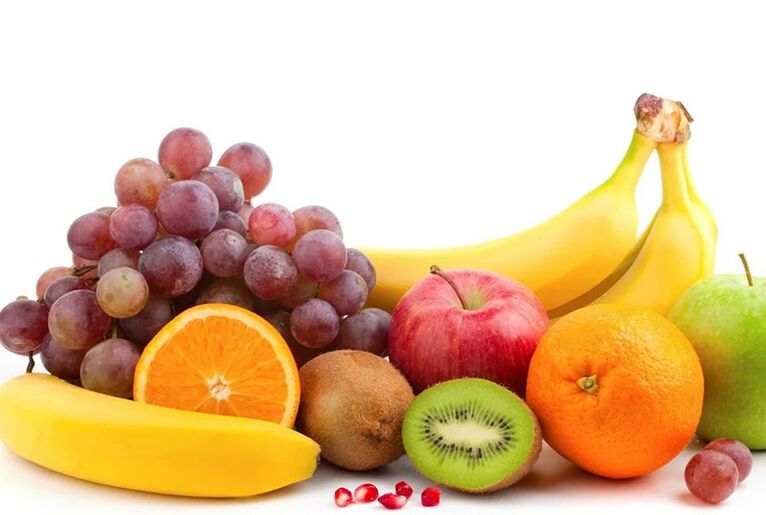
The diet is stopped after the pain and swelling in the legs are eliminated. It is not recommended to keep it for a long time, because the body will soon begin to lack vitamins and nutrients.
7-day menu
Approximate weekly diet for the treatment of gout:
| Eating | Monday | Tuesday | Wednesday | Thursday | Friday | Saturday | Sunday |
|---|---|---|---|---|---|---|---|
| Breakfast | Dandruff bread sandwich with jam, vegetable salad with sour cream sauce, hip decoction | Rice porridge with pumpkin milk, fresh orange | Oatmeal with butter and jam, homemade fruit jelly with pieces of pulp, herbal tea | Buckwheat porridge with milk, grated apple and carrot salad | Oatmeal with fried apples, berry marmalade, tea | Millet porridge with milk, soft-boiled egg, baked apple stuffed with nuts | Vegetable salad with cheese and sesame, potato pancakes with sour cream |
| Lunch | Greek yogurt, 2 biscuits | Fresh strawberries with cream | Skim milk corn flakes, various nuts | Curd foam with dried fruit | Corn flakes with yogurt and banana pieces | Ice cream with fruit and berry foam | Pancakes with jam and pieces of fruit |
| Supper | Vegetable broth with eggs and croutons, fried beets, carrot and apple salad, banana juice | Vegetable casserole with cheese, steamed chicken cutlets, berry jelly | Salmon vegetable soup, corn porridge, yogurt | Milk noodle soup, vegetable stew, carrots and fresh apples | Broccoli puree soup, potato zrazy with sour cream, fresh oranges | Cabbage soup, rice with seafood, milk jelly | Potato soup, vegetable stew with turkey meatballs, banana milkshake |
| Supper | Potato croquettes, slicing fresh vegetables, herbal tea with lemon | Stuffed with sour cream, cottage cheese with pieces of fresh fruit, compote | Potato casserole with vegetables and eggs, vegetable salad with flaxseed oil, lingonberry juice | Fried beets with garlic, oat jelly, fruit salad | Boiled young potatoes with herbs and butter, vegetable salad, dried fruit compote | Pumpkin stuffed with cheese, sliced vegetables with corn oil, fresh banana | Cucumber and tomato salad, broccoli cutlets with sour cream sauce, cheese cakes, bran juice |
| Before going to bed | Yogurt with fresh berries | Berry jam, biscuits with kefir | Rosehip juice, apples | Curd mass, pear | Milk souffle with fruit | Kefir, mandarin | Cottage cheese with sour cream, compote |
The items on the menu can be substituted, changed or added according to taste. The main thing is not to violate the basic principles of the diet.
Features of fasting days
Diet for gout excludes complete starvation, as it exacerbates the disease. It is recommended to follow a mono-diet (watermelon, potato, cucumber, carrot) on fasting days or to prepare salads, slices, stews from different types of vegetables and fruits.
Small amounts of dairy products and cereals are allowed. Rice fasting days are popular: they are boiled in milk and eaten in small portions with the addition of a small amount of grated apples.
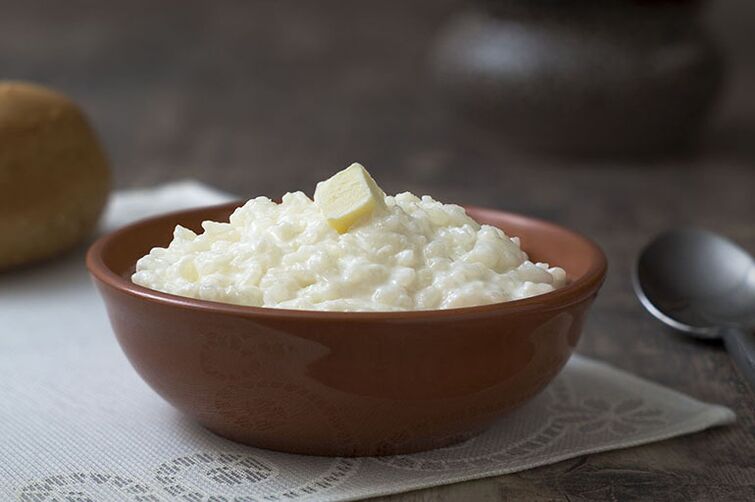
Fermented milk diet will help to get rid of excess uric acid quickly: it involves the use of only cottage cheese (400 g) and kefir (0. 5 liters) per day.
Recipes for gout
Therapeutic diet allows you to eat many familiar dishes: cereals, vegetable soups, stews, salads. They do not require expensive products or special cooking skills. You can diversify the menu using original recipes from the allowed ingredients so that the patient does not have to worry about boring, monotonous meals.
Light cream soup
Low calorie, but tasty and hearty enough for dinner. To prepare it, you will need the following products:
- 1 onion;
- 1 carrot;
- 1 bunch of spinach leaves
- 1 slice of white bread
- 2 x. glimmer juice;
- 2 x. qbitki oil;
- 1 ç. qkrem;
- 0, 5 ç. qSahara.
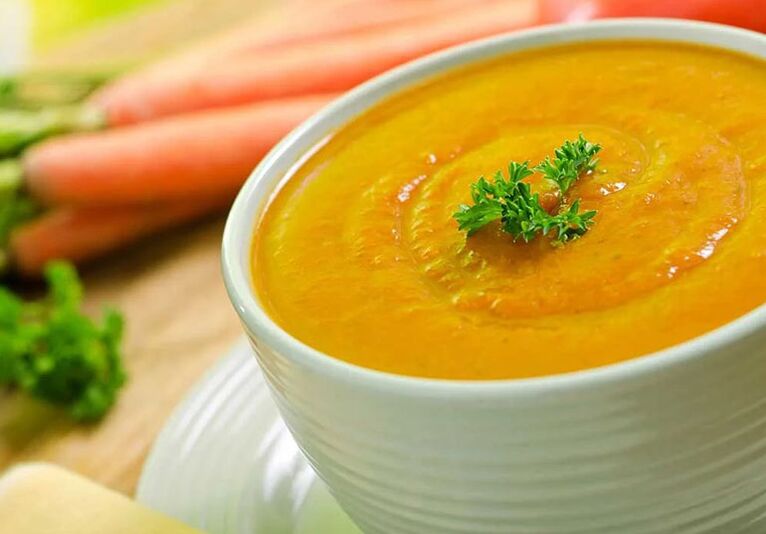
Cut the bread into small cubes and dry in a dry frying pan. Peel onions and carrots, chop finely. Pour oil into a deep pot, heat, put the vegetables and simmer for 6-7 minutes. Add spinach leaves and puree with a blender. Bring the mixture to a boil, add lemon juice and sugar. Remove from heat and arrange on plates. Add a little cream and white bread toast to each portion.
Curd casserole
The dish is used as a dessert or snack. To prepare it you will need:
- 140 g of cottage cheese;
- 70 q sour cream;
- 1 egg;
- 3 tbsp. l. semolina;
- 1 tablespoon. l. Sahara;
- 0, 5 ç. soda quenched with glimmer water;
- dried fruits, nuts to taste;
- salt.
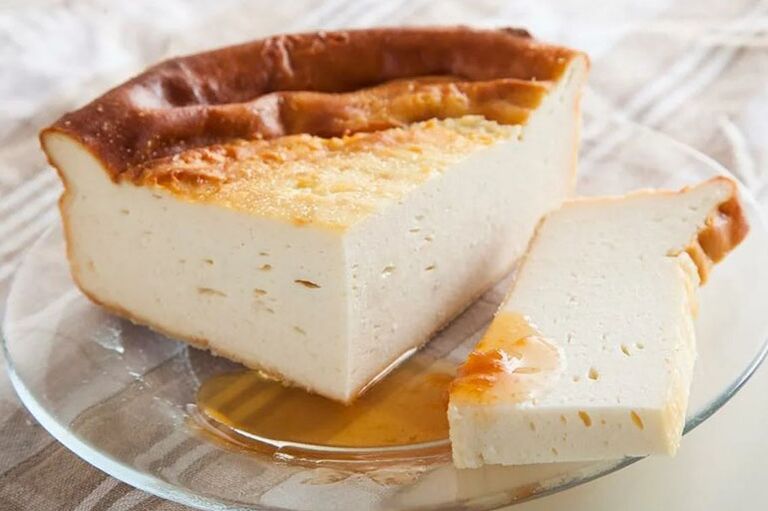
Mix the cream with the cream. Pour salt, sugar and semolina into the resulting mass. Add finely chopped dried fruits and nuts. Homogenize, mix with baking soda. The mass placed in a loaf pan should be placed in an oven preheated to 180 ° C and baked until golden brown.
Steamed chicken meatballs with sauce
A low-calorie main dish that can be eaten alone or with garnish. To cook you will need:
- 350 q chicken fillet;
- 2 onions;
- 1 carrot;
- 1 clove garlic;
- 1 egg;
- 1 tablespoon. rice;
- 70 g of white bread;
- 200 ml of vegetable juice;
- 50 q sour cream;
- 2 tbsp. l. milk;
- 0, 5 tbsp. l. un;
- green onions, parsley, dill to taste;
- vegetable oil for frying;
- salt.
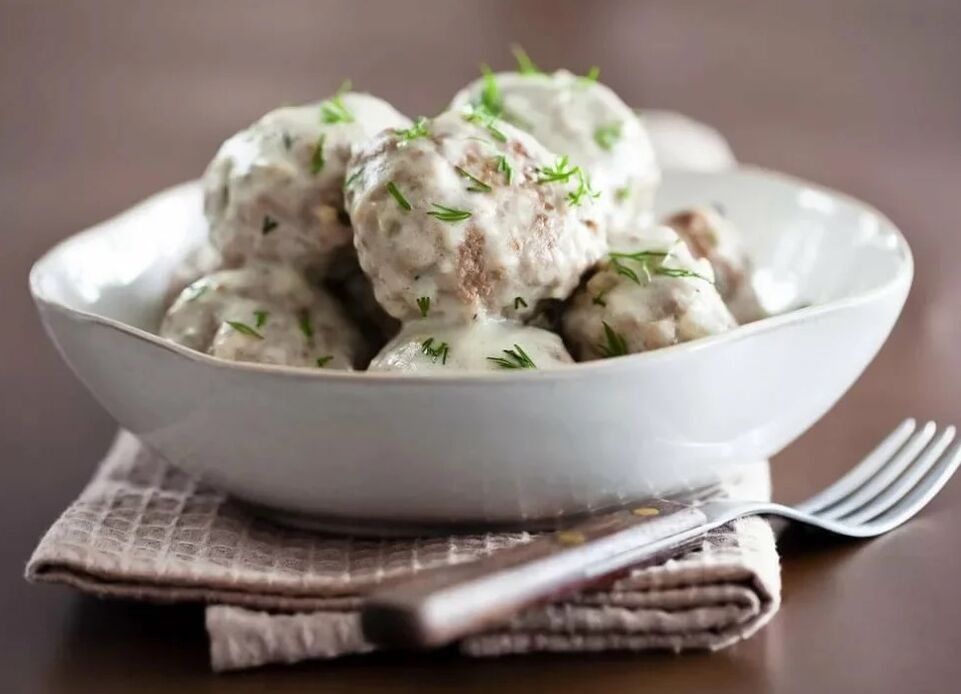
Soak the bread in milk. Boil the rice without salt and cool. Cut the chicken fillet into medium-sized pieces and place in a blender. Add 1 chopped onion, garlic, bread and herbs, beat in a raw egg and chop until smooth. After mixing with rice, add salt and keep in the refrigerator for 20 minutes. Then meatballs are formed and steamed for 6-8 minutes.
Finely chop the remaining onions and carrots. Fry the vegetables in oil for 2-3 minutes, pour into the broth, add flour and sour cream. Heat the sauce over low heat until thickened, add the meatballs and cook for 5-6 minutes. Sprinkle with herbs before serving.
Eggplant and minced stew
A saturated second course that is perfect for lunch or dinner. To prepare it, you need to take the following items:
- 300 g of minced meat;
- 2 large eggplants;
- 1 onion;
- 1 clove garlic;
- 3 tbsp. l. tomato paste;
- 2 tbsp. l. un;
- 120 g of hard cheese;
- 50 ml cream;
- vegetable oil;
- salt.
Cut eggplants into long slices, add salt to make juice. Dip in flour and fry in oil on both sides until half cooked. Chop the garlic and onion and fry until golden. Add the minced meat, cook for 3 minutes on medium heat, then the tomato paste. Pour 0, 5 tbsp. water, salt to taste. Cover and cook for another 5 minutes.
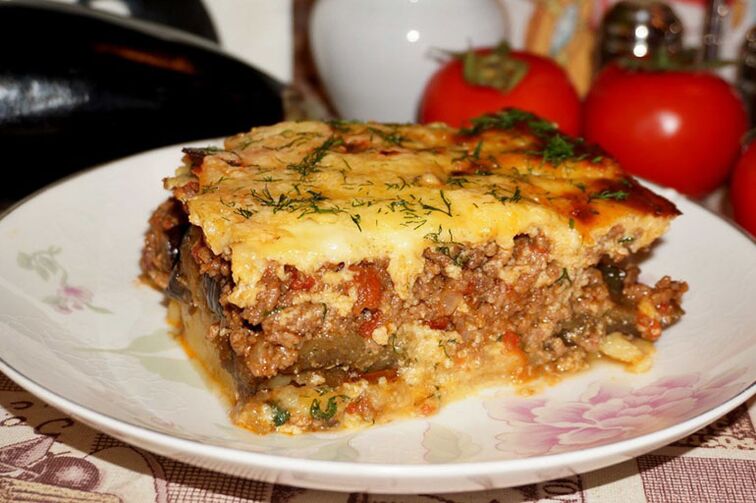
Place eggplant slices in a thick layer on a greased baking sheet, top with minced meat, followed by grated or sliced cheese. Pour the cream and bake in an oven preheated to 180 ° C for half an hour.
Pumpkin soup puree
The traditional first dish of the day. You need to take the following products to cook:
- 0, 5 kg pumpkin, peeled, films and seeds;
- 2 tbsp. l. butter;
- 2 tbsp. l. rice;
- 1 tablespoon. l sugar;
- 250 ml of milk;
- cream to taste;
- salt.
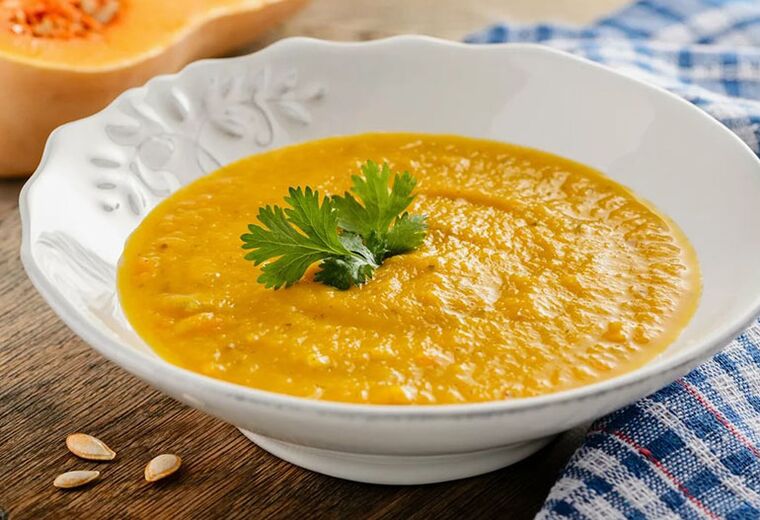
Cut the pumpkin into cubes, put in a pot, add rice, salt and sugar. Pour 1 liter of water and cook until soft. Pour the melted butter and sieve. Return to the oven, add milk and bring to a boil, then remove from heat. Spread the prepared pumpkin soup on plates and sprinkle with cream.
Dietitian's opinion
- "Adherence to a diet for gout is necessary for patients for a full life. Proper diet helps to eliminate pain and swelling and reduces the risk of complications. When designing the menu, it is worth paying attention to protein, because patients are often deprived of their usual products.
- "Gout diet is effective in lowering uric acid levels in the body. It is recommended to observe it throughout life to prevent exacerbation of the disease and to continue the asymptomatic course of the disease. "
- "Diet reduces uric acid levels in the body by about 15%. When combined with supportive medications, it is effective in treating gout. "
Disadvantages of diet for gout
The main disadvantage of the diet is that the food restrictions are quite strict. Even minor violations can exacerbate the disease. The diet is especially unpleasant for those who love meat and alcohol.
Another disadvantage of the diet is the lack of animal protein, which must be compensated by expensive and unusual dairy and plant products. In addition, the diet is not suitable for weight loss and is intended only for treatment.




















